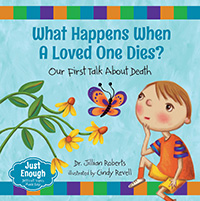| ________________
CM . . .
. Volume XXII Number 17. . . .January 8, 2016
excerpt:
Through simple, but effective questions, using a child’s voice and perspective, the author, Dr. Jillian Roberts, hopes to tackle a difficult issue in a sensitive way. An important topic, although awkward to discuss, death is truly part of the life cycle, and losing someone or something you love is a reality of life. Roberts covers the basics in a questions-and-answer format, with a focus in the beginning on nature and animals, then, slowly and sensitively connects the topic to humans. This format includes an explanation of terms that is simple, yet precise. Death is explained in an age-appropriate way, and the information is also linked to different cultural beliefs. The information increases in depth of detail, yet is subtle. The text, which has a story book quality, is soothing and, above all, is suitable to this age level. The book has extra questions at the end which can even reach a bit older audience in covering other related topics in the concept of death. In spite of what is a grim and serious topic, Revell’s watercolour illustrations are colorful, lively and child-like, with nature and the child’s surroundings playing a large role. Her drawings feature a variety of ethnicities and families which lends depth to this topic. Kuddo’s to Dr. Jillian Roberts for tackling a serious issue in such an accessible way. The author brings with her years of experience in this area, as both a teacher and a child psychologist. This title is part of a series, called “Just Enough: Difficult Topics Made Easy”. The series is well-labelled as the topics are given just enough information to be meaningful, give some insight, without being overwhelming, and can be starters to important conversations. What Happens When A Loved One Dies? can be a very useful tool for educators and parents as a way to deal with a challenging subject. Recommended. Reesa Cohen is a retired Instructor of Children’s Literature and Information Literacy at the Faculty of Education, University of Manitoba in Winnipeg, MB.
To comment
on this title or this review, send mail to cm@umanitoba.ca.
Copyright © the Manitoba Library Association. Reproduction for personal
use is permitted only if this copyright notice is maintained. Any
other reproduction is prohibited without permission.
Next Review |
Table of Contents for This Issue
- January 8, 2016. |
